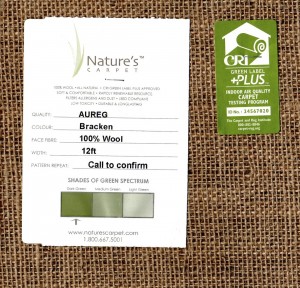 Continuing with the same credit from my previous post, LEED for Homes awards points for selecting materials with low emissions. You know that new home or office smell? It’s not good for you! Many people report head aches or respiratory illnesses after moving into new homes, so it was very important to us to make sure we did not choose materials that could make us or the workers sick. This could go under the section of Indoor Air Quality; I put it under the overall category of healthy home, which was our number one goal, regardless of the related LEED points.
Continuing with the same credit from my previous post, LEED for Homes awards points for selecting materials with low emissions. You know that new home or office smell? It’s not good for you! Many people report head aches or respiratory illnesses after moving into new homes, so it was very important to us to make sure we did not choose materials that could make us or the workers sick. This could go under the section of Indoor Air Quality; I put it under the overall category of healthy home, which was our number one goal, regardless of the related LEED points.
The first type of materials this part of the credit applies to are adhesives, sealants, paints and coatings. Limits are set on the amount of volatile organic compounds (VOCs) per given volume of the product. The LEED for Homes Reference Manual provides a table standards, based upon a Green Seal Standard or the South Coast Air Quality Management District Rule. For carpet and floors, the standard for low emissions is set by the Green Label Plus program or the FloorScore program. And for insulation, products must be certified by either the California Collaborative for High Performance Schools program or the GreenGuard Environmental Institute Children & Schools program.
This seems like a lot of work to check; I just sniffed everything and if it stunk, I did not want it my house. But I digress. Let’s see what we’ve got.
1. Flooring: a project can earn credit for low-emissions flooring if a) at least 90% of the flooring is CRI Green Label Plus carpet with CRI Green Label pad, OR b) at least 90% of the flooring is hard surface flooring, OR c) at least 90% of the flooring is a combination of CRI Green Label Plus carpet (with Green Label pad) and hard surface flooring. The Carpet and Rug Institute (CRI) Green Label Plus certifies carpets for low emissions. We chose a wool carpet that is certified, and we love it. The rest of our flooring is hard surface. 0.5 point.
2. Paints, coatings, and primers applied to interior walls and ceilings have VOC standards: they must be 50 grams per liter (g/L) for flats and 150 g/L for nonflats. Clear wood finish lacquers must be less that 550 g/L and 350 g/L for varnishes. Sealers must be 250 g/L. (There are more standards for shellacs, stains, floor coatings, and antirust paints, but we did not use them so I won’t bore anyone with the details). We were very specific about all of our paints and finishes. The concrete sealant we used was provided by Green Building Supply, meeting the standard. All paints were no-VOC Benjamin Moore Aura, so we met that requirement and our house did not stink when we moved in! The interior wood finish we used on the windows was Agualente, which is GreenGuard certified and has a VOC level of 100 g/L, easily beating the requirement for low emissions. When I asked the guy who was applying the Agualente how it had performed for them in the past, he said he didn’t know because he had never used it before. But, he added, it was nice to go home without heartburn! We do get just 0.5 point for all that, but it was more than worth it — for our everyone’s health.
3. Adhesives and sealants must comply with a long list of VOC content levels. While we were quite clear what we wanted in this area, there were so many different types of caulkings and adhesives used that I do not think it would be possible for me to verify that every one of them complied with the standards. I would have had to be at the house every day (I almost was) examining every little tube each worker was using. While I guess that we did comply, I’m not going to count a half point here because I just can’t be sure. If we end up 0.5 point away from gold, I’ll come back to this one.
4. Roof and floor and wall insulation: comply with California “Practice for Testing of VOCs from Building Materials Using Small Chambers.” We used closed-cell polyurethane spray foam. While a few spray foam insulators are listed on the GreenGuard website, our exact type does not seem to be listed, so I have to assume it did not comply. I’ve been assured that once the insulation is sprayed, it becomes completely inert, and there is no off-gassing. So while we do not get a half point, it was worth it for the energy savings.
Points for low emissions: 1
Materials & Resources points so far: 10
Cumulative points: 67.5
Additional points needed to get to Gold: 20.5

